Complete Guide to On-Page SEO for Australian Businesses
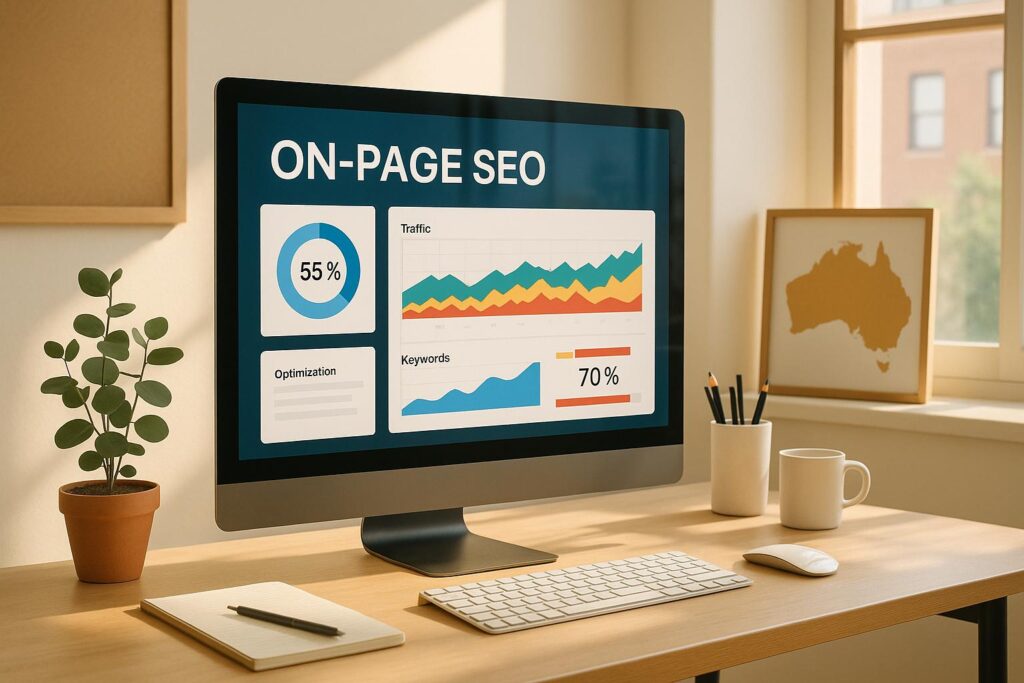
Last Updated on 6 October 2025 by Dorian Menard
On-page SEO is crucial for Australian businesses that want to improve their online visibility and attract local customers. With 68% of searches in Australia happening on mobile devices and 46% of Google searches having local intent, optimising your website for local audiences can directly impact revenue. Key points include:
- Technical setup: Improve page speed, structure URLs, and optimise headings and alt text for search engines.
- Meta tags: Write concise, keyword-rich titles and descriptions with Australian spelling and location-specific phrases.
- Schema markup: Add LocalBusiness schema with accurate address, phone number (+61 format), and operating hours.
- Localised content: Use Australian English, include location-specific keywords, and reference local events or landmarks.
- Mobile-first optimisation: Ensure fast load times, mobile responsiveness, and user-friendly navigation.
Despite economic challenges like 7.3% inflation, businesses that invest in SEO can stand out in a less competitive digital landscape. Local SEO leads convert 17% better, and 78% of location-specific mobile searches lead to purchases within 24 hours. This is the reason why you need to optimise your website for local SEO traffic.
This guide breaks down actionable steps to help your business rank higher and connect with Australian audiences effectively.
Core On-Page SEO Elements for Australian Websites
To make your website stand out in the Australian market, getting the basics of on-page SEO right is essential.
With Google commanding over 94% of the search engine market share and mobile searches accounting for more than 65% of traffic in cities like Sydney, Melbourne, and Brisbane, tailoring your website to local needs is more important than ever.
At the heart of effective on-page SEO are three key areas: crafting meta tags that speak directly to Australian searchers, creating content that resonates with local audiences, and using structured data to help search engines better understand your location and offerings.
Writing Meta Tags with Australian English
Your title tags and meta descriptions are often the first things potential customers notice in search results.
That makes them prime real estate for grabbing attention. Keep your title tags short and impactful – aim to include primary keywords within the first 60 characters. And don’t forget to use Australian spelling (e.g., ‘optimisation’, ‘colour’, ‘centre’). For meta descriptions, stick to around 160 characters and weave in location-specific phrases like “best cafes in Sydney” or seasonal terms such as “summer specials”.
Adding seasonal and local references can make your meta tags even more appealing. For example, during the Australian summer (December to February), phrases like “holiday hours” or “summer deals” can boost relevance. Similarly, referencing major events, like the Melbourne Cup or Australia Day, can help you connect with your audience and drive click-through rates.
Remember, 81% of consumers research online before making a purchase. So, make your meta tags work hard by clearly communicating your value and relevance to Australian users.
Pro tip: Always include your brand name at the end of your title tags. It’s one of the simplest but most overlooked ways to strengthen brand recognition and trust in search results. When users repeatedly see your brand attached to valuable content, it reinforces credibility and helps establish your name as an authority in your niche. It also improves click-through rates, especially for returning visitors who already recognise your business.
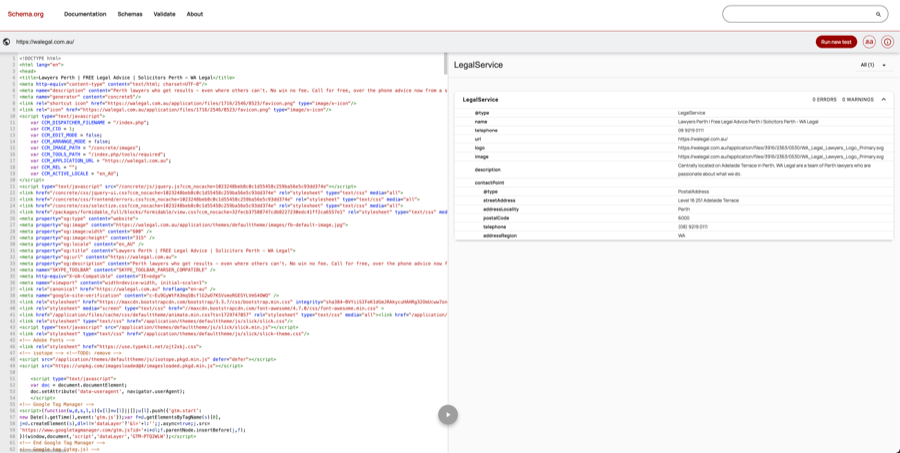
Adding Local Schema Markup
Schema markup is a type of structured data that makes it easier for search engines to understand your business. For Australian companies, using local schema markup correctly can significantly improve visibility in location-based searches.
Ensure your LocalBusiness schema includes complete and accurate Australian details, such as your street address, suburb, state, postcode, and phone number in the +61 format. Include opening hours, accounting for local holiday closures, and add review data to build trust.
Review schema allows you to showcase customer feedback directly in search results, which is crucial since Australians often rely on reviews before making purchasing decisions. Include ratings, review counts, and snippets of customer feedback to make your listing stand out.
For businesses hosting events, Event schema can be a game-changer. Include details like accessibility, parking, and public transport options – practical information that Australian audiences often look for when planning their visit.
Don’t forget to include Australian-specific details like your ABN, GST registration status, and accepted payment methods (e.g., EFTPOS, PayPal, Afterpay) in your LocalBusiness schema. These details can enhance trust and transparency.
Incorporate schema markup as part of your broader local SEO strategy. Pair it with optimised Google Business Profile content and locally relevant blog posts to maximise visibility. By focusing on these elements, you’ll be well on your way to dominating local search results in Australia.
Technical On-Page Setup for Australian Websites
Nailing the technical aspects of on-page SEO is a must for Australian websites. With mobile users making up the bulk of internet traffic in major cities and local factors like geography occasionally affecting site speed, technical optimisation plays a key role. These adjustments complement your content strategies, giving you an edge in the competitive Australian market.
The technical backbone of your site affects how search engines crawl and index your pages. It also determines whether visitors stay engaged or leave within seconds. Let’s break down the essential technical elements that Australian businesses need to focus on.
Faster Page Load Speed
Page speed isn’t just a nice-to-have – it’s critical for Australian websites, especially with the dominance of mobile browsing in urban areas. If your site takes more than 3 seconds to load, up to 53% of mobile users will abandon it, which can severely hurt conversions.
Google recommends keeping page speeds under 3 seconds, and for good reason: a 0.1-second improvement in load time can increase conversion rates by 8% for eCommerce sites and 10% for travel sites. On the flip side, as load time jumps from one to three seconds, bounce rates increase by 32%.
Start by choosing a hosting provider with servers based in Australia to reduce latency. Managed WordPress hosting, VPS, or dedicated servers are great options for better performance. Adding a Content Delivery Network (CDN) with Australian Points of Presence (POPs) can also significantly speed things up.
To optimise your site further:
- Compress images and use formats like WebP, keeping file sizes under 100KB .
- Enable Gzip compression to shrink file sizes before they reach your visitors’ browsers.
- Minify and combine your HTML, CSS, and JavaScript files to cut down on HTTP requests.
- Leverage browser caching so returning users don’t have to reload static files.
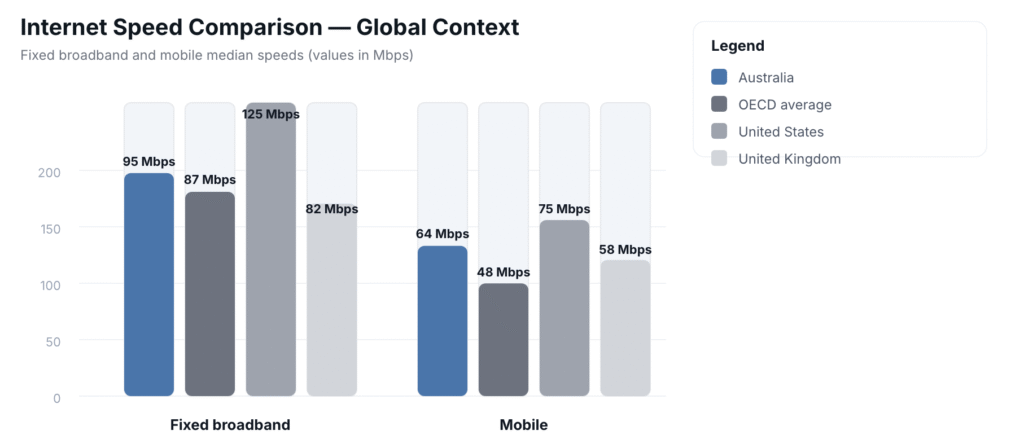
Internal Linking Methods
Once your site speed is sorted, focus on internal linking to guide users and search engines through your content. This is particularly important for Australian businesses targeting regional audiences.
Use clear, descriptive anchor text to make navigation intuitive. For example, instead of generic phrases like “click here”, opt for specific links like “our complete guide to Google Ads management” or “Melbourne SEO case studies.” This not only helps users but also signals relevance to search engines.
Create topic clusters by linking a central pillar page to related supporting pages. For instance, a main page on plumbing services could link to specific pages about emergency repairs or bathroom renovations.
Other tips include:
- Adding breadcrumb navigation to show users where they are on your site.
- Building hub pages that act as comprehensive resources for specific topics.
- Regularly auditing your internal links with tools like Google Search Console to identify and fix orphaned pages.
Setting Up Technical Elements Correctly
For Australian websites, where mobile-first usage is common and local nuances matter, getting these technical details right is essential:
- Write descriptive alt text for all images, using Australian spelling conventions. For example, “colour consultation” instead of “color consultation.” The alt text should explain the image’s content and context clearly.
- Structure heading tags logically. Use one H1 per page for your main keyword, H2s for key sections, and H3s for subsections.
- Keep your URL structure clean and keyword-rich. For instance, “yoursite.com.au/plumbing-services-melbourne” works far better than a vague or cluttered URL.
- Choose lightweight, well-coded themes like GeneratePress, Astra, Kadence, or Blocksy. Regularly review your plugins and disable any that aren’t necessary to reduce code bloat and potential security risks.
Additional tips:
- Enable lazy loading for images and videos, which ensures media only loads as users scroll down the page. This is especially helpful for mobile users on limited data plans.
- Set up 301 redirects for any changed URLs to maintain link equity and avoid frustrating users who land on broken links.
- Clean up your database by removing spam comments, outdated accounts, and unnecessary data. This keeps query response times fast.
Creating Content for Australian Audiences
Content that connects with Australian audiences should feel relatable and conversational. Use a direct tone, throw in some contractions, and don’t shy away from local slang or cultural references.
Mentioning iconic landmarks like the Sydney Harbour Bridge, Melbourne’s laneways, or Perth’s beaches can help build an immediate connection. Similarly, weaving in references to events like Anzac Day or the AFL Grand Final can make your content feel more relevant. There are many ways you can write location specific content for your website.
Voice search is growing rapidly in Australia – by an estimated 35% annually. To align with this trend, structure your content to answer conversational queries. For example, if someone asks, “Where’s the best coffee in Melbourne?”, your content should naturally include phrases like “Melbourne coffee roaster” or “best cafes in Melbourne.”
Keyword integration is crucial, but it needs to feel natural. Use both primary and secondary keywords throughout your headings, subheadings, and body copy. Localised phrases, such as “Sydney wedding photographer” or “Brisbane family lawyer,” can help you rank higher in search results.
To truly understand what resonates with your audience, conduct local market research through surveys or interviews. Check out what your competitors are doing and identify gaps in their strategies. Partnering with local influencers can also be a great way to create content that feels authentic and relevant.
Tools and Services for On-Page SEO
When it comes to managing on-page SEO for Australian businesses, having the right tools can make all the difference. With nearly half of Australian searches showing local intent and Google holding a commanding market share, it’s essential to use tools that can track performance, reveal opportunities, and ensure accuracy across platforms. Effective SEO tools provide actionable data, which is crucial given that 78% of local mobile searches result in purchases within 24 hours.
Using Google Search Console and SEMrush
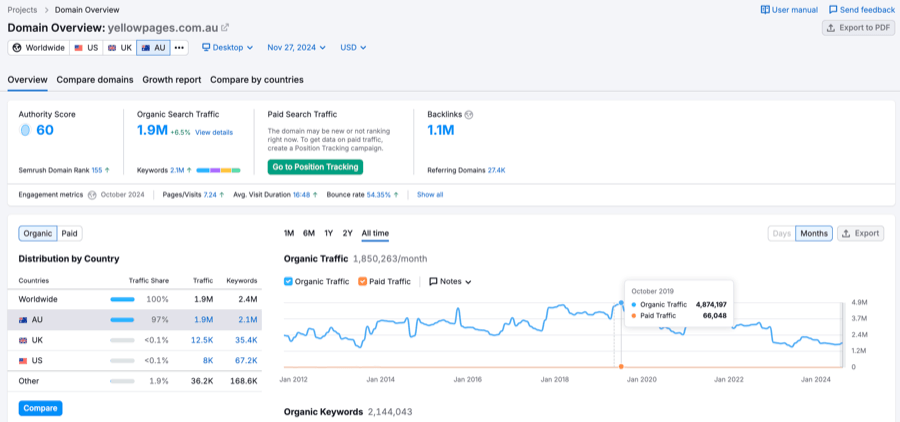
Google Search Console is a must-have tool. Not only is it free, but it also offers valuable insights into search performance, indexing issues, and site errors.
“Google Search Console helps SEO by providing insights into search performance, indexing issues, and site errors.”
For a quick win, start by identifying first-page keywords with low click-through rates. By optimising titles and meta descriptions for these pages, you can nudge these “almost-there” keywords (those ranking in positions 7–10) into the top 5. The tool also tracks Core Web Vitals and provides recommendations to improve website speed and mobile usability – key factors under Google’s mobile-first indexing.
SEMrush complements these capabilities with a range of features, starting at A$117.33 per month (billed annually). It offers rank tracking, competitor analysis, and tools to uncover local SEO opportunities tailored for the Australian market. By integrating Google Analytics and Google Search Console with SEMrush, you can centralise your website data for a full-picture analysis. Here is a full review of Semrush.

This setup also helps identify backlink opportunities from relevant Australian publications. While Google Analytics focuses on user behaviour, Google Search Console monitors your site’s search performance, and SEMrush provides a deeper dive into SEO metrics.
Together, these tools not only track performance and reveal local SEO possibilities but also lay the groundwork for advanced strategies provided by agencies like Search Scope.
How Search Scope Supports On-Page SEO
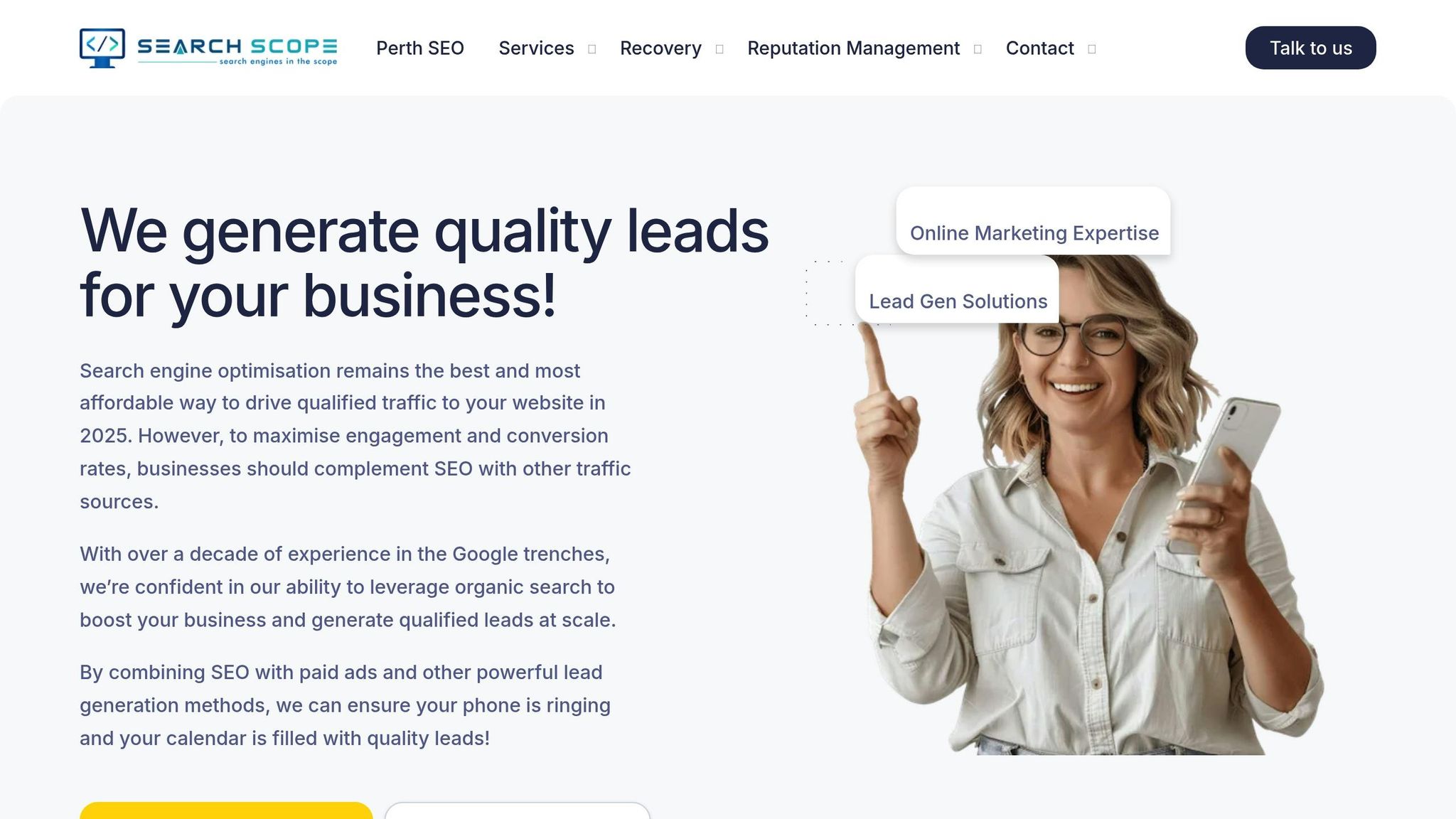
Search Scope takes these analytical insights and transforms them into strategies designed specifically for Australian businesses. Founded by Dorian Menard, who brings over a decade of SEO experience across local, national, and international projects, the agency understands the unique hurdles faced by businesses in Australia.
“Our holistic approach to search engine marketing combines technical expertise, strategic content development, link building and market insights to help your business rank higher and reach your target audience.” – Search Scope
Local SEO is at the heart of Search Scope’s on-page optimisation services. The agency focuses on targeted keywords, citations, location-specific landing pages, and schema markup to help businesses dominate local search results – a critical factor when nearly half of Google searches have local intent.
Search Scope also turns your Google My Business (GMB) profile into a lead-generating powerhouse. By managing and optimising your GMB listing, they boost visibility in local searches and Google Maps. Our reputation management services further enhance your online presence by promoting positive reviews and addressing any negative feedback.
For e-commerce businesses, Search Scope offers tailored services like technical SEO, on-page optimisation, internal linking, content strategy, and link building. These are essential for success, especially considering that 44% of online shopping journeys begin with a Google search. Their advanced tools, such as geo-grid rank tracking, provide detailed insights into how your website performs across different Australian regions, helping you identify and target regional opportunities.
Search Scope’s results speak volumes. In just six months, they increased organic non-branded traffic by 3000% for a KPMG Australia travel client, securing a top 3 position for the site’s main keyword, which garners around 12,000 monthly searches.
E-commerce packages start at A$1,999 per month for entry-level services and go up to A$4,999 per month for elite packages. This investment covers everything from technical audits to ongoing optimisation and performance monitoring, offering a comprehensive approach to SEO success.
Long-Term On-Page SEO Success in Australia
Achieving long-term on-page SEO success for Australian businesses calls for a blend of technical expertise, tailored content, and continuous updates. With 46% of Google searches having local intent and 78% of location-based mobile searches leading to in-person purchases within 24 hours, the importance of local SEO cannot be overstated.
The backbone of this success is localisation. This means tailoring your content strategy to Australian English, using local terms, and creating pages that genuinely meet the needs of your audience. Local SEO efforts also deliver results, with local leads converting 17% better than non-local ones – a compelling reason to prioritise this approach.
Mobile optimisation is another non-negotiable, especially since 68% of all searches are conducted on mobile devices. Ensuring your site is mobile-friendly is a critical step in enhancing user experience and search rankings.
Technical maintenance is equally crucial. SEO isn’t a “set it and forget it” process. Google’s algorithms are constantly evolving, so staying ahead means regularly reviewing and updating key elements like meta tags, schema markup, Core Web Vitals, and your business’s NAP (Name, Address, Phone number) data. These updates ensure your website remains competitive and aligned with search engine standards.
Building trust within your community is also vital. With 88% of people reading online reviews before choosing local services, encouraging customer feedback and engaging with your audience can set your business apart. This kind of authentic connection not only boosts credibility but also strengthens your position in local search results.
FAQs
How can Australian businesses use schema markup to boost local search rankings?
Australian businesses can boost their visibility in local search results by incorporating schema markup. This structured data provides search engines with detailed information about your business, such as its name, address, phone number, operating hours, and services. By using schema types like LocalBusiness or Organisation, search engines gain a clearer understanding of your business’s local relevance, which can lead to better rankings in local search results and on Google Maps.
For the best results, ensure your schema markup reflects Australian-specific details. This includes using correct address formatting, metric measurements, and localised descriptions of your services. Taking this tailored approach makes your business more relevant to Australian users and increases the chances of featuring in rich search results, such as knowledge panels or featured snippets.
How can I optimise meta tags to better target an Australian audience?
To fine-tune meta tags for an Australian audience, start by crafting clear, descriptive title tags that reflect your page’s content while seamlessly incorporating relevant, localised keywords. Think about using terms that resonate with Australians, like specific city names or phrases unique to the region.
Next, focus on writing compelling meta descriptions. These should include keywords but, more importantly, should entice users to click by addressing their needs and featuring a clear call to action. Keep them short and sharp – ideally between 150–160 characters – while sticking to Australian spelling conventions (e.g., ‘optimise’ instead of ‘optimize’).
Lastly, adapt your meta tags to fit local search habits. Consider Australian cultural preferences and nuances to help your content stand out in a competitive local search environment.
What is the impact of mobile-first optimisation on on-page SEO for Australian businesses?
Mobile-first optimisation is a game-changer for improving on-page SEO, especially for Australian businesses aiming to connect with their audience. With more Australians relying on smartphones for online searches, having a mobile-friendly, fast, and responsive website is no longer optional – it’s essential.
Google’s mobile-first indexing puts the spotlight on your mobile site’s performance when deciding search rankings. In simple terms, if your mobile site delivers a smooth experience, you’re more likely to see better search visibility, increased organic traffic, and stronger user engagement. Prioritising mobile-first design helps businesses not only keep up with the competition in Australia’s digital space but also meet the expectations of today’s mobile-savvy users.